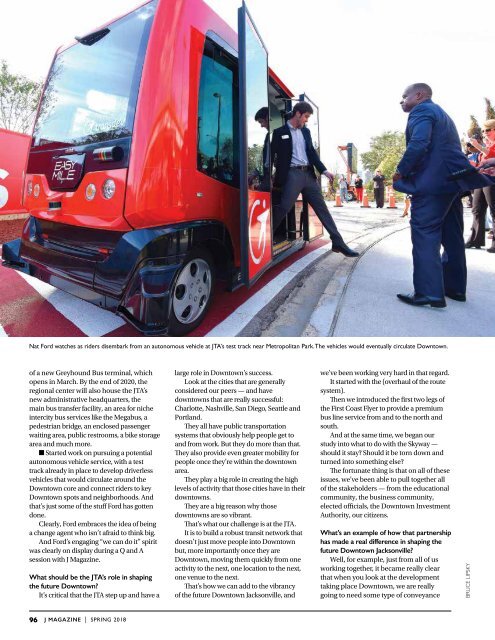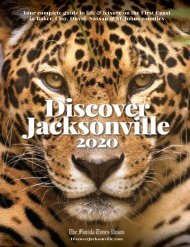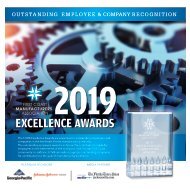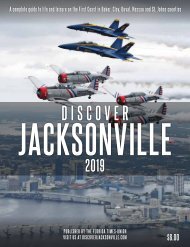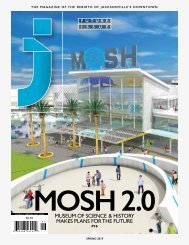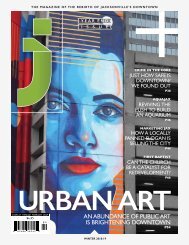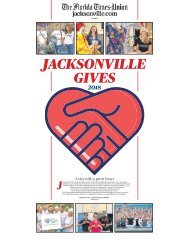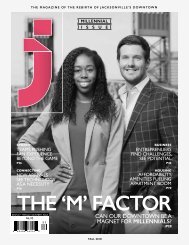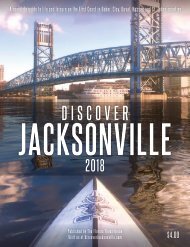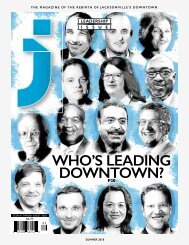J Magazine Spring 2018
You also want an ePaper? Increase the reach of your titles
YUMPU automatically turns print PDFs into web optimized ePapers that Google loves.
Nat Ford watches as riders disembark from an autonomous vehicle at JTA’s test track near Metropolitan Park. The vehicles would eventually circulate Downtown.<br />
of a new Greyhound Bus terminal, which<br />
opens in March. By the end of 2020, the<br />
regional center will also house the JTA’s<br />
new administrative headquarters, the<br />
main bus transfer facility, an area for niche<br />
intercity bus services like the Megabus, a<br />
pedestrian bridge, an enclosed passenger<br />
waiting area, public restrooms, a bike storage<br />
area and much more.<br />
n Started work on pursuing a potential<br />
autonomous vehicle service, with a test<br />
track already in place to develop driverless<br />
vehicles that would circulate around the<br />
Downtown core and connect riders to key<br />
Downtown spots and neighborhoods. And<br />
that’s just some of the stuff Ford has gotten<br />
done.<br />
Clearly, Ford embraces the idea of being<br />
a change agent who isn’t afraid to think big.<br />
And Ford’s engaging “we can do it” spirit<br />
was clearly on display during a Q and A<br />
session with J <strong>Magazine</strong>.<br />
What should be the JTA’s role in shaping<br />
the future Downtown?<br />
It’s critical that the JTA step up and have a<br />
large role in Downtown’s success.<br />
Look at the cities that are generally<br />
considered our peers — and have<br />
downtowns that are really successful:<br />
Charlotte, Nashville, San Diego, Seattle and<br />
Portland.<br />
They all have public transportation<br />
systems that obviously help people get to<br />
and from work. But they do more than that.<br />
They also provide even greater mobility for<br />
people once they’re within the downtown<br />
area.<br />
They play a big role in creating the high<br />
levels of activity that those cities have in their<br />
downtowns.<br />
They are a big reason why those<br />
downtowns are so vibrant.<br />
That’s what our challenge is at the JTA.<br />
It is to build a robust transit network that<br />
doesn’t just move people into Downtown<br />
but, more importantly once they are<br />
Downtown, moving them quickly from one<br />
activity to the next, one location to the next,<br />
one venue to the next.<br />
That’s how we can add to the vibrancy<br />
of the future Downtown Jacksonville, and<br />
we’ve been working very hard in that regard.<br />
It started with the (overhaul of the route<br />
system).<br />
Then we introduced the first two legs of<br />
the First Coast Flyer to provide a premium<br />
bus line service from and to the north and<br />
south.<br />
And at the same time, we began our<br />
study into what to do with the Skyway —<br />
should it stay? Should it be torn down and<br />
turned into something else?<br />
The fortunate thing is that on all of these<br />
issues, we’ve been able to pull together all<br />
of the stakeholders — from the educational<br />
community, the business community,<br />
elected officials, the Downtown Investment<br />
Authority, our citizens.<br />
What’s an example of how that partnership<br />
has made a real difference in shaping the<br />
future Downtown Jacksonville?<br />
Well, for example, just from all of us<br />
working together, it became really clear<br />
that when you look at the development<br />
taking place Downtown, we are really<br />
going to need some type of conveyance<br />
BRUCE LIPSKY<br />
96<br />
J MAGAZINE | SPRING <strong>2018</strong>


